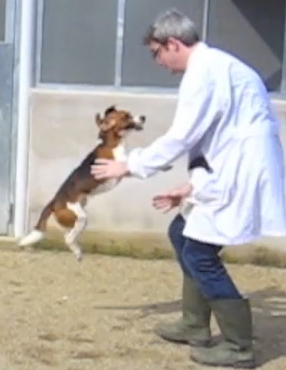A cure for type 1 diabetes
February 14, 2013

Diabetic dog cured from the disease (credit: UAB)
Researchers at the Universitat Autònoma de Barcelona (UAB) have succeeded in completely curing type 1 diabetes in dogs with a single session of gene therapy by introducing a “glucose sensor” into muscle.
This is the first time the disease has been cured in large animals, a fundamental step towards applying the therapy in humans. The dogs recovered their health and no longer show symptoms of the disease. In some cases, monitoring continued for over four years, with no recurrence of symptoms.
The therapy is minimally invasive. It consists of a single session of various injections in the animal’s rear legs using simple needles that are commonly used in cosmetic treatments.
These injections introduce gene therapy vectors, with a dual objective: to express the insulin gene and glucokinase genes. Glucokinase is an enzyme that regulates the uptake of glucose from the blood.
When both genes act simultaneously, they function as a “glucose sensor,” which automatically regulates the uptake of glucose from the blood, thus reducing diabetic hyperglycemia (the excess of blood sugar associated with the disease).
The study provides ample data showing the safety of gene therapy mediated by adeno-associated vectors (AAV) in diabetic dogs. It is based on the transfer of two genes to the muscle of adult animals using a new generation of very safe vectors known as adeno-associated vectors. These vectors, derived from non-pathogenic viruses, are widely used in gene therapy and have been successful in treating several diseases.
Long-term control of the disease
Dogs treated with a single administration of gene therapy showed good glucose control at all times, both when fasting and when fed, improving on that of dogs given daily insulin injections, and with no episodes of hypoglycemia, even after exercise. Furthermore, the dogs treated with adeno-associated vectors improved their body weight and had not developed secondary complications four years after the treatment.
There have been multiple clinical trials in which AAV vectors have been introduced into skeletal muscle, so the strategy reported in this study is feasible for clinical translation, the researchers say.
The study was led by the head of the UAB’s Centre for Animal Biotechnology and Gene Therapy (CBATEG) Fàtima Bosch, and involved the Department of Biochemistry and Molecular Biology of the UAB, the Department of Medicine and Animal Surgery of the UAB, the Faculty of Veterinary Science of the UAB, the Department of Animal Health and Anatomy of the UAB, the Spanish Biomedical Research Centre in Diabetes and Associated Metabolic Disorders (CIBERDEM), the Children’s Hospital of Philadelphia (USA) and the Howard Hughes Medical Institute of Philadelphia (USA).
Diabetes mellitus
Diabetes mellitus is the most common metabolic disease, and a large number of patients need insulin treatment to survive. In spite of the use of insulin injections to control the disease, these patients often develop serious secondary complications like blindness, kidney damage or amputation of limbs. Moreover, in order to achieve good blood glucose control, insulin has to be injected two or three times a day, which brings a risk of hypoglycemia episodes (lowering of blood sugar): an additional problem that comes on top of the other hardships of the treatment.
